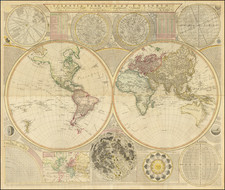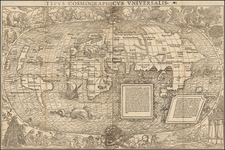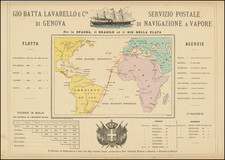One of the First Depictions of the Peninsula of California -- Attached To Asia!
Girolamo Ruscelli's Carta Marina Nuova Tavola, based on Gastaldi's 1548 map, provides a unique historical insight into the world's geography as understood in the 16th century. The map, rendered in fine copperplate engraving, is a highly valued collector's item, not least because it provides one of the earliest depictions of the California peninsula.
This map presents an unusual worldview, with the belief in a continuous northern landmass, the isthmus reported by Verrazano in 1524, effectively enclosing the northern continents in a ring. This was a popular concept at the time, with both Gastaldi and Ruscelli advocating for an Asia-America connection.
In the eastern part of the map, Greenland is depicted as an extension of Scandinavia, a misconception derived from Waldseemuller's work. The connection of North America and Europe is similarly unusual, rooted in two distinct inaccuracies.
Turning towards the Atlantic coast, the map notes an unnamed cape, pointing upwards. This feature, thought to be Cape Cod, can be traced back to Ramusio's map of 1534 and Ribero's manuscript chart of 1529. It is believed to reflect the exploratory journey of Estavao Gomes along the New England coast.
In Asia, the writings of Marco Polo are represented, although modern corrections have been integrated. These details and depictions create a captivating snapshot of 16th-century geographic knowledge and misconceptions, making Ruscelli's Carta Marina Nuova Tavola a significant artifact in the history of cartography.
Girolamo Ruscelli (1500-1566) was a cartographer, humanist, and scholar from Tuscany. Ruscelli was a prominent writer and editor in his time, writing about a wide variety of topics including the works of Giovanni Boccaccio and Francesco Petrarch, Italian language, Italian poetry, medicine, alchemy, and militia. One of his most notable works was a translation of Ptolemy’s Geographia which was published posthumously.
There is limited information available about Ruscelli’s life. He was born in the Tuscan city of Viterbo to a family of modest means. He was educated at the University of Padua and moved between Rome and Naples until 1548, when he moved to Naples to work in a publishing house as a writer and proofreader. He remained in the city until his death in 1566.









![Hemisphere Septentrional du Globe Terrestre Veu en concave l'oeil estant au Pole AntArctique . . . 1696 [and] Hemisphere Superieur du Globe Terreste pour l'Horizon de Paris Veu en convexe l'oeil etant pose au zenith et a distance infinie du plan de projection . . . 1697](https://storage.googleapis.com/raremaps/img/small/85541.jpg)



![[Pan American Menu Map] (World)](https://storage.googleapis.com/raremaps/img/small/104021.jpg)
![P. Mc.D. Collins' Proposed Overland Telegraph Via Behring's Strait and Asiatic Russia to Europe, Under Russian & British Grants. . . 1864 [accompanied by separate text:] Communication of Hon. William H. Seward, Secretary of State, upon the subject of an Intercontinental Telegraph connecting the Eastern and Western Hemispheres by way of Behring's Strait, In Reply to Hon Z. Chandler, Chairman of The Committee on Commerce of the U.S. Senate, To Which Was Referred The Memorial of Perry McDonough Collins.](https://storage.googleapis.com/raremaps/img/small/87461.jpg)